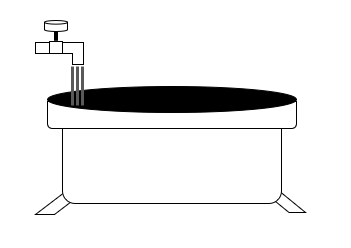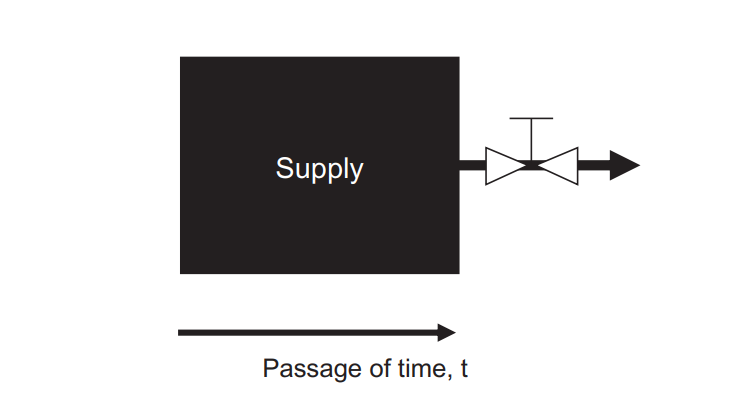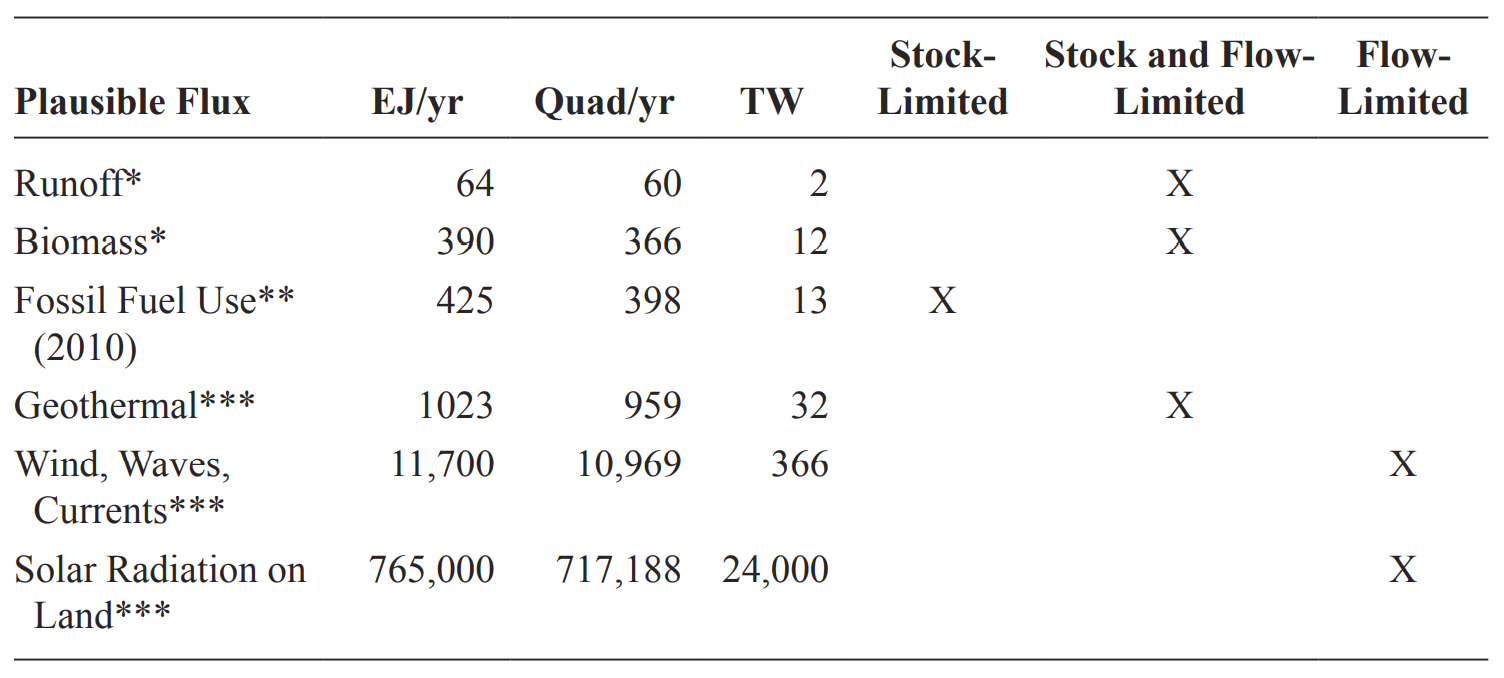[
energy
]
Energy sources are popularly divided into two categories: “nonrenewable” and “renewable.” Nonrenewable energy sources are the fossil and nuclear fuels, coal, oil, gas, and uranium, while the renewable energy sources are classified as hydropower and “new” renewable energy, including wind, solar, geothermal, and biofuels. I’m not foolish enough to think I can change this, but the naming convention is problematic for a number of reasons.
One important reason is that many resources tend to straddle both categories under various conditions and really do not lend to being defined in absolutes – renewable vs. nonrenewable. It’s way too simplistic to do that. Another important reason has to do with the use of “renewability” as a category in general, because it incorrectly connotes that resources falling into this category are somehow limitless in their utilization. In many real, quantifiable ways, nonrenewable AND renewable resources are limited—nonrenewables are limited by their stocks and renewables are limited by their flows. In her book, Thinking in Systems, Dr. Donnella Meadows makes an excellent effort to describe these concepts (not just for energy but for many environmental systems), which I’ll expand on in this blog entry.*
STOCK LIMITATIONS
Nonrenewable energy resources, again, are generally considered to be the fossil fuels (coal, oil, and gas) and uranium. The fossil fuels represent millions of years of accumulated sun-earth capital. As Vaclav Smil put it, “fossil fuels were formed through slow but profound changes of accumulated biomass under pressure and heat, and their ages range from millions to hundreds of millions of years.” The quantities available are immense and demonstrate the gargantuan potential of solar energy when it is concentrated over many, many years. Uranium, on the other hand, is an ancient endowment of fissile material – a one time gift to Earth by primordial supernovae. It is not nearly as abundant as fossil fuel stocks, however the energy contained within each kilogram of fissile material makes uranium an equally significant source of primary energy.
Our use of these finite resources is almost entirely dictated by the amount of mineral deposits known to be available for exploitation, and the economic conditions that allow for their extraction – the more expensive a barrel of oil is or a kilogram of uranium ore is on the trade market, the more favorable it is for an oil or uranium ore company to extract from the ground.
What this ultimately means is that the entire nonrenewable mineral stock on earth is, theoretically, “available at once.” Thinking of a bathtub tends to offer a useful conceptualization. All the oil that we’ll ever find is stored within the bathtub, or the sum of all reservoirs. We can add to the bathtub with new discoveries or better recovery technology from past discoveries, but ultimately there is a finite amount of oil stored in Earth’s crust. If we continue to drain the tub, it will eventually empty out.

So, civilization’s consumption of these resources is controlled by the total amount of mineral deposits known to be “in the ground” and available for exploitation, as well as the technical, economic, and environmental factors that allow for their practical and continued extraction. The simple depiction below is another helpful way to think of how humanity is using the fossil fuel resource supply.

Starting at time t1, we have a known supply that we can extract. These are resources we have in reserve that can be extracted right now. As time progresses to t2, t3, etc, the supply is reduced by the difference in the rate of extraction from the rate of additions. The big arrow at the bottom is our extraction flow and is really only limited by our need/want for the resource. The smaller “additions” arrow is also important because we can also add to the reserves supply from the estimated total resource base (i.e. all the stuff we can theoretically extract but have yet to be placed into reserves and ready for immediate extraction) by making new discoveries, or by improving recovery via better engineering technologies and practices. We can also extend reserves availability by consuming less via efficiency enhancements or conservation practices. Basically, we can slow the draw down by being more efficient with how we use the energy source or by choosing to use less altogether.
In the end, however, since the total resource stock is not renewed (at least not on time frames equal to how we have been consuming them), it will not be available indefinitely. Moreover, the faster we extract them for our needs and wants (the bigger the extraction arrow in the depiction), the sooner that supply will be depleted; thus, they are stock-limited. (Ben Ebenhack and I have had many conversations about the idea of “depletability” as a better term than nonrenewable or even stock-limited.)
Keep in mind that coal, oil, gas, and uranium all have tabulated reserves, meaning that the known available, exploitable mineral stock of each resource is immediately available to use. These stocks are rather sizeable, and because they are well established in the global resource supply infrastructure and are the basis for how we have created machines to serve our end uses, they have allowed for a high degree of predictability for the global economy. We can keep the “lights on” and move about all the time because these resources are exceedingly abundant, highly transportable, and are available to be exploited at any time.
What is unsettling about this, and as Smil correctly points out, is that this accumulated solar capital is being drawn down by humans “at rates that will exhaust it in a tiny fraction of the time that was needed to create it.” This reason more than even environmental concerns is why I believe we should be expanding our energy portfolio.
FLOW LIMITATIONS
In contrast to fossil energy, “renewables” (there goes that word again), particularly solar and wind energy, are best described as flow-limited energy supplies. That is, our consumption of these resources is controlled by the flow of sunlight or flow of wind onto the energy collector (e.g., a panel or a turbine). There are no reserves of sunlight or wind from which to draw, but rather the energy must be used and/or converted immediately as it is collected from its practically nondepletable supply (i.e., the sun or wind); however, it is limited to the incident flow rate, as depicted below.

The valve in the figure above is meant to convey that when the sun is not shining or the wind is not blowing sufficiently over Earth-based collectors, no substantial energy will be available to utilize. The valve shuts off and the available supply is no longer available. The benefit of relying on solar and wind energy flows is that the amount of energy used at any given time has no direct effect on how much is available in the future. That is, the supply does not change. The penalty of using this type of supply, however, is that we are subject to the relative availability of the originating supply at any given moment. If the sun is not shining or the wind is not blowing, the valve is shut and we cannot use them directly.
So, “renewable” resources are those resources that can be extracted in near “real time” and can be harvested indefinitely. Implicit in this definition is the point that when using renewable resources, there are no substantial stocks from which to draw, except in certain instances, and even that is available for very short periods of time compared with the accumulated stocks available from the nonrenewable resources, which took eons to form. Thus, renewable resources are flow-limited resources.
Again, classic examples of flow-limited energy are solar energy and anything derived from it: movement of air from wind and waves, movement of water as part of the hydrologic cycle, and biomass generated from photosynthesis. In our first book, The Path to More Sustainable Energy Systems, Ben and I argue that we should only consider solar, wind and wave, and run-of-river hydropower to be truly renewable, flow-limited energy, because for these kinds of resources, the amount used today has no direct effect on how much is available tomorrow. For example, solar energy is flow-limited because the influx of solar radiation to earth is relatively constant and, more importantly, not diminished by humanity’s use of it. No matter how much solar energy we use, we do nothing to deplete the sun. We only collect the radiation for heat or the light for electricity. Similarly, the present and future availability of wind, wave, and minimally manipulated hydropower cannot be affected by our current consumption of energy derived from them.
But remember, we are constrained by the relative availability of renewable, flow-limited energy sources. When the sun is not shining or the wind is not blowing adequately onto their respective collectors, no substantial energy is available for utilization without the availability of some sort of integrated chemical or other storage – batteries. The intermittency of these sources makes them difficult to depend on as standalone primary energy. Stock-limited energy remains essential to the human endeavor.
IN-BETWEEN RESOURCES: RENEWABLE, STOCK, AND FLOW-LIMITED ENERGY
Meadows makes a key point in Thinking in Systems about flow-limited renewable energy– she states that if the rate of extraction occurs faster than the rate of regeneration, “they may eventually be driven below a critical threshold and become, for all practical purposes, nonrenewable.” This is what I call “in-between energy.”
Photosynthesis, the hydrologic cycle, and the radioactive decay that leads to geothermal heating are all continuous earth-bound processes and an annual energy flux that can be harnessed from these processes can be plausibly estimated for these sources. In my first book I wrote with Ben, we summarized these values using a 2010 base case fossil fuel usage, which I share below.

Note that the most readily available large-scale energy – hydropower, biomass, and geothermal – have been harnessed by humanity in a manner that is more similar to how we utilize the fossil fuels. That is, we tap accumulated, short-term stocks of these certain types of renewable energy that can and do replenish at rates much quicker than fossil fuel replenishment rates. However, there are two caveats. First, the quantity of the accumulated stocks is much smaller than the accumulated stocks of the fossil fuels. Second, it is possible to deplete the stocks being tapped to a point where the rate of depletion of these finite accumulations exceeds the flux of the process to replenish those stocks. Thus, the energy resources tapped from these inherent processes—biomass energy, stored hydropower, and geothermal energy—are stock and flow-limited energy. They possess a combination of the advantages and disadvantages of both flow and stock-based resources.
Biomass
The use of biomass for energy is an ancient practice, and the harnessing of this energy in a traditional society would have taken “a few months (crops harvested for food and fuel), a few years (… shrubs, young trees), or a few decades (mature trees) to become usable” (again, see Smil). Because photosynthesis is a continuous process, biomass is commonly referred to as renewable. Certainly, it is possible to consume biomass at rates that do not significantly diminish the existing stock, but it is possible to over-consume them as well. And while it further can be argued that it is possible for humans to contribute to the renewal of biomass (re-planting what is harvested), it is also true that most consumption of biofuels has not been at a full renewal rate, thus we have depleted reserves (e.g., forests) wherever urbanizing societies have been or currently remain dependent on biomass for building and as a primary energy source. Modern biofuel production, like biodiesel or fuel alcohol, has some potential to be managed better in terms of re-planting, but increased biofuel production is very likely to encroach on and erode the soils of lands needed for other agricultural products or on forests and natural grasslands. In this case, the land is a finite resource.
Stored Hydropower
Stored hydropower systems that we typically associate with the hydro resource utilize dams that restrict the natural flow of water in the hydrologic cycle, thus creating a reservoir of stored gravitational energy. The larger this dam is, the larger the reservoir is, and the larger the stock of available energy that can be used for producing useful electricity. In essence, this man-made system converts a flow-limited process into a stock-limited process at specific sites, but flow limitations are perhaps a bit more important in this system because hydropower plants still depend on water flow—if water does not collect upstream of the dam, less water will flow through the hydropower plant. Again, because hydropower depends on the hydrologic cycle, it is typically considered to be renewable, however this convention has come into question because large dam systems in particular alter both the natural flow of the river and sedimentation patterns to the extent that the reservoir behind the dam ultimately silts up and may become useless. Also, tapping a natural energy flux means that it is not as available elsewhere, as it would have been if not tapped.
Geothermal Energy
Geothermal energy is particularly difficult to classify. First there are two distinct versions of geothermal energy use: small-scale, localized use for heating and cooling; and larger scale use for electric power generation. In the first case, geothermal heating and cooling clearly represent a renewable, flow-limited system. The small-scale use is unlikely to have a noticeable effect on the energy flux near the Earth’s surface. Furthermore, these systems are commonly used for both heating and cooling, so heat is both extracted from and returned to the ground. Large-scale geothermal power production, though, generally involves drilling wells into geologic reservoirs that are unusually hot, then producing steam up through a well-bore, like an artificial geyser. The large-scale geothermal fields do extract tremendous amounts of heat with the steam produced and ultimately cool the reservoir. Since the steam reservoir—a stock—is surrounded by hot rock, it can deplete, but can be expected to build back up after production is halted for sufficiently long.
CONCLUSION
It is unfortunate that primary energy has been classified the way it has, because the naming incorrectly implies that the resources in these categories are either limited (nonrenewable) or limitless (renewable) in their utilization within the global supply. Supply is ultimately a physical limitation of how much energy is produced and efficiently used by human-controlled systems. And since supply is physical, each energy source has ultimate physical limits, either due to the finiteness of the resource (the actual fuel) or the finiteness and inefficiency of the infrastructures and technologies used to harness the energy from the resource (for example, the solar panel and its components).
It’s also unfortunate that the environmental argument can blind us from the benefits that stock-limited fossil and nuclear fuels provide. Stock-limited energy, using Meadows’s words, permits “life to proceed with some certainty, continuity, and predictability.” The stores are rather sizeable and exist right now to draw from. But, as a consumption-heavy humanity moves forward this century with the assurance that existing nonrenewable stocks will diminish substantially by around 2050 (if not sooner), it will be important to compare the potential of other sources to current consumption.
Again, the type of source affects both how the energy is acquired and what form it takes. All of the stock-limited energy sources (fossil fuels) are extracted from existing, natural storage at rates based on physical factors and local, regional, and global demand. The flow-limited resources (solar and wind) can only be harvested locally at the rates of their natural flow. That is, the energy is converted to its final form at the point of capture. Since the source is not always available on demand, these flow-limited resource systems often require battery storage to meet demand when needed, if they are providing a large share of the total power—which is the case for a stand-alone solar or wind power system.
The many sources that have aspects of both flow and stock limitations tend to use their stock characteristics so that energy can be produced at rates determined by demand. Finally, most “new” renewable technologies are being employed to generate electricity. The current model in developing these energy systems is based on the large-scale centralized power generation model that emulates coal and nuclear power systems. This incurs the efficiency losses associated with long distance electric power transmission. This is particularly true for wind because the windiest sites are not typically located near large population centers. Although sunshine is more appealing, the sunniest sites must have relatively little cloud cover—and little rain. The Sahara, for example, offers great solar potential but is remote from population centers. As we consider the availability of energy resources and their use in the 21st century, as well as the role of energy efficiency in utilizing and extending resource lifetimes, we must keep in mind these two primary categories of stock and flow limitations.
Lastly, the table I shared above lists the energy potential from a number of renewable sources, accounting for plausibly accessible (although not necessarily exploitable) fluxes and compares it to the 400 Quads per year of fossil fuel use (the 2010 rate). It is evident that the greatest potential comes from solar and wind resources; however, this is flow-limited energy. It does not align well with how humanity uses energy presently, and represents an immense obstacle to any proposed transition away from nonrenewable, stock-limited energy consumption. It’s not impossible, it’s just really hard.
References
Donella Meadows. Thinking in Systems: A Primer. 2008. Chelsea Green Publishing. —> Publisher’s Site
Vaclav Smil. Energy: A Beginner’s Guide. 2017. Simon and Schuster. —> Publisher’s Site
Daniel Martínez and Ben Ebenhack. The Path to More Sustainable Energy Systems. 2013. Momentum Press. —> Publisher’s Site